Equuleus constellation lies in the northern sky. Its name means “little horse” or “foal” in Latin. The foal constellation is associated with several Greek myths, most notably the one about Hippe, the daughter of the centaur Chiron and the nymph Chariclo. The creator of the constellation is unknown, but Equuleus was introduced by the Greek astronomer Claudius Ptolemy in the 2nd century CE along with other Greek constellations.
Equuleus is a small, faint constellation with few notable deep sky objects and no stars brighter than fourth magnitude. It is sometimes also known as Equus Primus, or the First Horse, because it rises just before the constellation Pegasus. The larger Pegasus represents the winged horse in Greek mythology.
Facts, location and map
Equuleus is the second smallest constellation in the night sky, after Crux (the Southern Cross). It occupies only 72 square degrees.
The constellation is located in the fourth quadrant of the northern hemisphere (NQ4) and can be seen at latitudes between +90° and -80°. The neighboring constellations are Aquarius, Delphinus and Pegasus.
The constellation name Equuleus is pronounced /ɪˈkwuːliəs/. In English, the constellation is known as the Little Horse or Foal. The genitive form of Equuleus, used in star names, is Equulei (pronunciation: /ɪˈkwuːliaɪ/). The three-letter abbreviation, adopted by the International Astronomical Union (IAU) in 1922, is Equ.
Equuleus does not have any stars brighter than magnitude 3.00 or located within 10 parsecs (32.6 light years) of Earth. The brightest star in the constellation is Kitalpha, Alpha Equulei, with an apparent magnitude of 3.919. The nearest star, HD 200779, is 48.41 light years distant from Earth. Equuleus contains three stars with known exoplanets. HD 200964 (spectral class K0IV) has two planets, while WASP-90 (F6) and HAT-P-65 (G2) have one transiting planet each.
The constellation contains one formally named star. The star name approved by the International Astronomical Union (IAU) is Kitalpha (Alpha Equulei A).
Equuleus does not contain any Messier objects and there are no meteor showers associated with the constellation. Equuleus belongs to the Heavenly Waters constellation family, along with Carina, Columba, Delphinus, Eridanus, Piscis Austrinus, Puppis, Pyxis, and Vela.
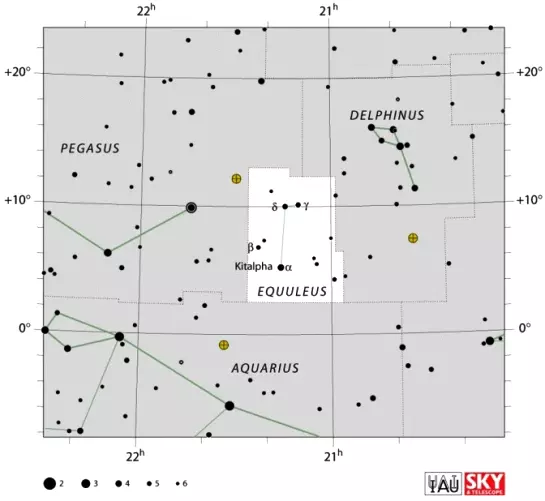
Equuleus constellation map by IAU and Sky&Telescope magazine
How to find Equuleus
Equuleus is not too difficult to find but can be challenging to spot from light-polluted areas because its stars are relatively faint. The constellation lies between Enif, the brightest star in the other horse constellation (Pegasus), and Altair, the luminary of Aquila, near the distinctive diamond-shaped pattern of Delphinus. Pegasus is easy to recognize because it is dominated by a prominent asterism known as the Great Square of Pegasus. Enif lies west of the asterism. Altair is one of the brightest stars in the sky and part of the Summer Triangle, a conspicuous asterism also formed by Vega and Deneb, that appears high overhead during the northern hemisphere summer. Altair is easily recognized because it is flanked by two fainter stars, Tarazed and Alshain.
The stars Delta and Gamma Equulei appear on the imaginary line that connects Enif and Altair, while Kitalpha and Beta Equulei appear south of the line.
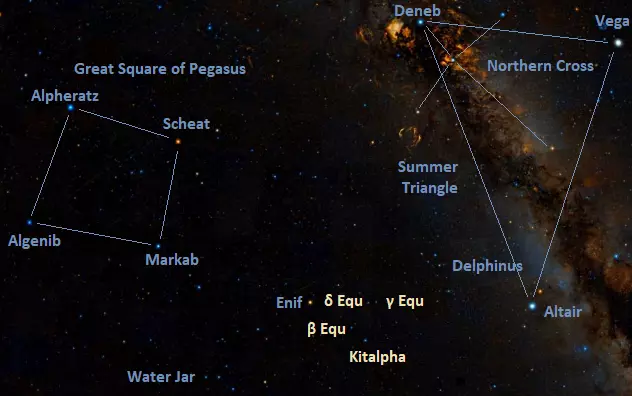
The location of Equuleus, image: Wikisky
Equuleus myth
Equuleus, the little horse constellation, is usually associated with Hippe, the daughter of the centaur Chiron in Greek mythology. In Greek lore, Hippe was seduced by Aeolus and became pregnant with his child. Too ashamed to tell her father, she hid the pregnancy from Chiron. She escaped to the mountains and stayed there until she gave birth to the child, named Melanippe.
When Chiron came looking for Hippe, she prayed to the gods that he doesn’t find her and they turned her into a mare. In one version of the tale, it was the goddess Artemis who placed Hippe among the constellations. She still appears to be hiding from Chiron, with only her head showing behind Pegasus. (Chiron is represented by the constellation Centaurus.)
Equuleus constellation is also sometimes associated with Celeris, a foal given as a present to Castor by Mercury. The name Celeris means “speed” or “swiftness.” The foal was either the brother or offspring of Pegasus, the famous winged horse, represented by the larger neighboring constellation.
Major stars in Equuleus
Kitalpha – α Equulei (Alpha Equulei)
Alpha Equulei is a spectroscopic binary star composed of a yellow giant of the spectral type G7III and a chemical peculiar white main sequence star with the stellar classification kA3hA4mA9. The system has a visual magnitude of 3.919 and is approximately 190 light years distant. It is the brightest point of light in Equuleus.
The primary component has a mass 2.3 times that of the Sun and a radius 9.2 times solar. With an effective temperature of 5,100 K, it is 52.5 times more luminous than the Sun. The companion is hotter, smaller and slightly less massive, with a size of 2.6 solar radii and a mass of 2.0 solar masses. With a surface temperature of 8,150 K, it shines with 26.3 solar luminosities. The star’s estimated age is 740 million years.
The traditional name of the primary component, Kitalpha, is derived from the Arabic phrase qiṭ‘a(t) al-faras which means “a piece (or section) of the horse.”
δ Equulei (Delta Equulei)
Delta Equulei is the second brightest star in Equuleus. It is a binary system with a combined visual magnitude of 4.47, located at a distance of 59.4 light years. Both components have the stellar classification F7V, indicating white main sequence stars. The primary component is brighter, with an apparent magnitude of 5.19, while the companion shines at magnitude 5.52. The two stars orbit each other with a period of 2,084.03 ± 0.10 days.
Both stars are slightly larger and more massive than the Sun. The primary component has a mass of 1.192 solar masses and a radius of 1.30 solar radii, while the companion has 1.187 solar masses and a size of 1.25 solar radii. The estimated age of the primary component is 3 billion years.
γ Equulei (Gamma Equulei)
Gamma Equulei is another double star. It lies at a distance of 118 light years from Earth and has an apparent magnitude that varies from 4.58 to 4.77.
Gamma Equulei is classified as a rapidly oscillating Ap (roAp) star, a chemically peculiar class A star that shows short-period variations in brightness. The star’s spectrum corresponds to an A9 main sequence star, but with an overabundance of strontium, chromium, and europium. The star exhibits pulsations with periods of about 12 minutes.
The companion is a magnitude 8.69 star separated by 1.26 arcseconds from the primary.
β Equulei (Beta Equulei)
Beta Equulei is a white main sequence star of the spectral type A3V. It is 4.02 times larger than the Sun and 78.3 times more luminous. Its estimated age is 600 million years. The star has an apparent magnitude of 5.19 and lies approximately 133 light years away. It has four visual companions but is not physically associated with any of them.
ε Equulei (Epsilon Equulei)
Epsilon Equulei is a multiple star consisting of four components. The star system has a combined visual magnitude of 5.23 and lies about 180 light years from the Sun. Its estimated age is about 1.5 billion years. The components Epsilon Equulei A and B are both class F main sequence stars slightly more massive than the Sun. The component A has 1.74 solar masses and component B, 1.53 solar masses. The two stars orbit each other with a period of 101.5 years. They have apparent magnitudes of 5.96 and 6.31. Epsilon Equulei A is believed to be a spectroscopic binary star.
The fourth component, designated Epsilon Equulei C, is separated by about 10 arcseconds from the main pair. It is considerably fainter, with an apparent magnitude of 7.35.
ζ Equulei (Zeta Equulei)
Unlike its brighter neighbours, Zeta Equulei is a single star. It is an orange giant of the spectral type K5III. The star has a visual magnitude of 5.593 and lies at a distance of 770 light years from Earth. It has a radius of 63 solar radii and, with a surface temperature of 3,893 K, it is 949 times more luminous than the Sun.
λ Equulei (Lambda Equulei)
Lambda Equulei is another binary star in the constellation. It has a combined apparent magnitude of 6.698 and lies 260 light years away. The system is too faint to be visible to the unaided eye.
The primary component, Lambda Equulei A, has a visual magnitude of 7.41. It is a main sequence star of the spectral type F6V. It has a mass of 1.73 solar masses and a radius 3.37 times that of the Sun. With a surface temperature of 6,561 K, it shines with 13.087 solar luminosities. The star’s estimated age is 1.6 billion years.
Lambda Equulei B is smaller and fainter (mag. 7.64) than the primary component. It has a radius 2.74 times solar and shines with 10.828 solar luminosities.
9 Equulei
9 Equulei is a red giant on the asymptotic giant branch (AGB). It has the stellar classification M2IIIa. The star has an apparent magnitude of 5.798 and lies at a distance of 740 light years. It is 58 times larger and 720 times brighter than the Sun.
4 Equulei
4 Equulei is another binary star. The primary component is a white main sequence star of the spectral type F8V, about 160 light years distant. With an apparent magnitude of 5.94, it is visible to the unaided eye, but only in exceptionally good conditions.
4 Equulei has a mass of 1.39 solar masses and a radius about 1.2 times solar. With an effective temperature of 6,213 K, it is 4.98 times more luminous than the Sun. The star’s estimated age is 3.07 billion years.
HD 199942
HD 199942 is a double star with a combined apparent magnitude of 5.98. It lies at a distance of 184 light years. The star system has the stellar classification F1Vp, indicating that the primary component is a chemically peculiar white main sequence star. The two stars orbit each other with a period of 58.4 years.
The brighter component has an apparent magnitude of 6.23. It has a mass of 1.65 solar masses and a radius 1.97 times that of the Sun. It is 10.2 times more luminous than the Sun. The star’s estimated age is 1.016 billion years.
The companion is significantly fainter, with a visual magnitude of 8.13.
6 Equulei
6 Equulei is a white main sequence star of the spectral type A2Vs. It is believed to be the primary component in an astrometric binary system, where the companion is not visible. The star lies at a distance of 380 light years and has a visual magnitude of 6.07. It is an optical companion to Gamma Equulei and sometimes referred to as Gamma Equulei D, even if the stars are not physically related. They are separated by 336 arcseconds.
6 Equulei has a mass 2.59 times that of the Sun and a radius 1.7 times solar. With an effective temperature of 9,078 K, it is 70.6 times more luminous than the Sun. Its estimated age is 970 million years.
HD 200964
HD 200964 is an orange subgiant star of the spectral type K0 IV. It has a visual magnitude of 6.64 and lies at a distance of 237.3 light years from the Sun. The star has a mass of 1.45 solar masses and a radius 4.92 times that of the Sun. Its estimated age is 3.3 billion years.
Two large extrasolar planets were announced to be orbiting the star in July 2010. The inner planet orbits at a distance of 1,601 astronomical units and the outer one at 1,950 astronomical units. The planet closer to the star is almost double the mass of Jupiter, while the more distant planet is slightly less massive than Jupiter. The inner planet has an orbital period of 613.8 days and the outer one completes an orbit around the star every 825 days.
In 2019, indications of a low-mass third planet (with 0.05 Jupiter masses) were reported in a study measuring the orbital parameters of the two known planets. However, the presence of the third planet has not been confirmed.
Deep sky objects in Equuleus
NGC 7015
NGC 7015 is a spiral galaxy with a visual magnitude of 13.25 and an apparent size of 1.9 x 1.6′. It lies at a distance of 203.2 million light years. It was discovered by French astronomer Édouard Stephan in 1878.
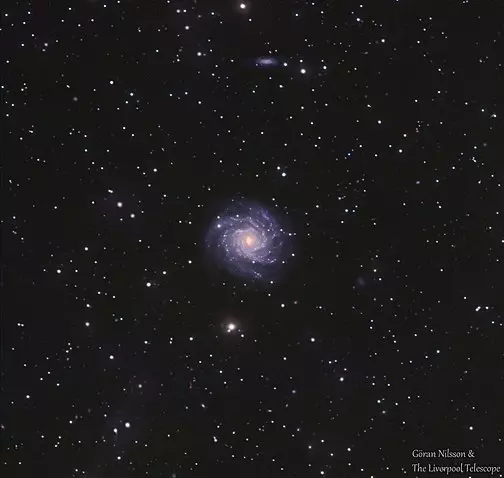
NGC 7015, image: Göran Nilsson & The Liverpool Telescope (CC BY-SA 4.0)
NGC 7040
NGC 7040 is another spiral galaxy in Equuleus. It has an apparent magnitude of 14.9 and lies 257.5 million light years away. It was discovered by American astronomer Mark Harrington in 1882.
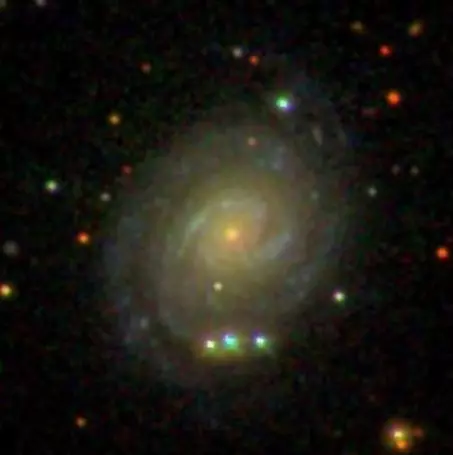
NGC 7040, image: Sloan Digital Sky Survey
NGC 7046
NGC 7046 is a barred spiral galaxy with an apparent magnitude of 13.75 and an apparent size of 1.9 x 1.3′. It lies at a distance of 176 million light years from Earth. The galaxy was discovered by William Herschel in October 1790.
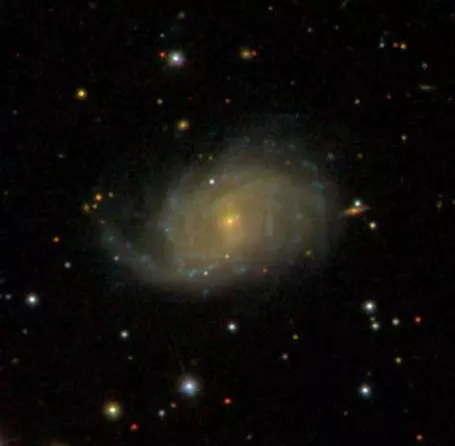
NGC 7046, image: Sloan Digital Sky Survey
NGC 7045
NGC 7045 is not really a deep sky object, but a binary star in Equuleus. It was discovered by John Herschel in July 1827 and included on the list of NGC objects. It has a visual magnitude of 12.0.